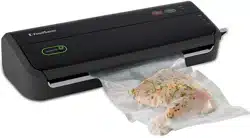Documents: Go to download!
- Owner's manual - (English)
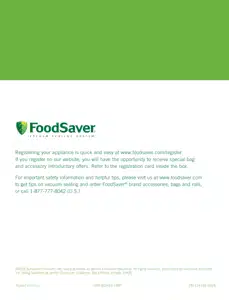
- FEATURES
- OPERATION
- SEALING
- FOOD PREPARATION AND REHEATING
- CARE & CLEANING
- TROUBLESHOOTING
- IMPORTANT TIPS
Table of contents
Food Saver Vacuum Seal Machine Manual
FEATURES
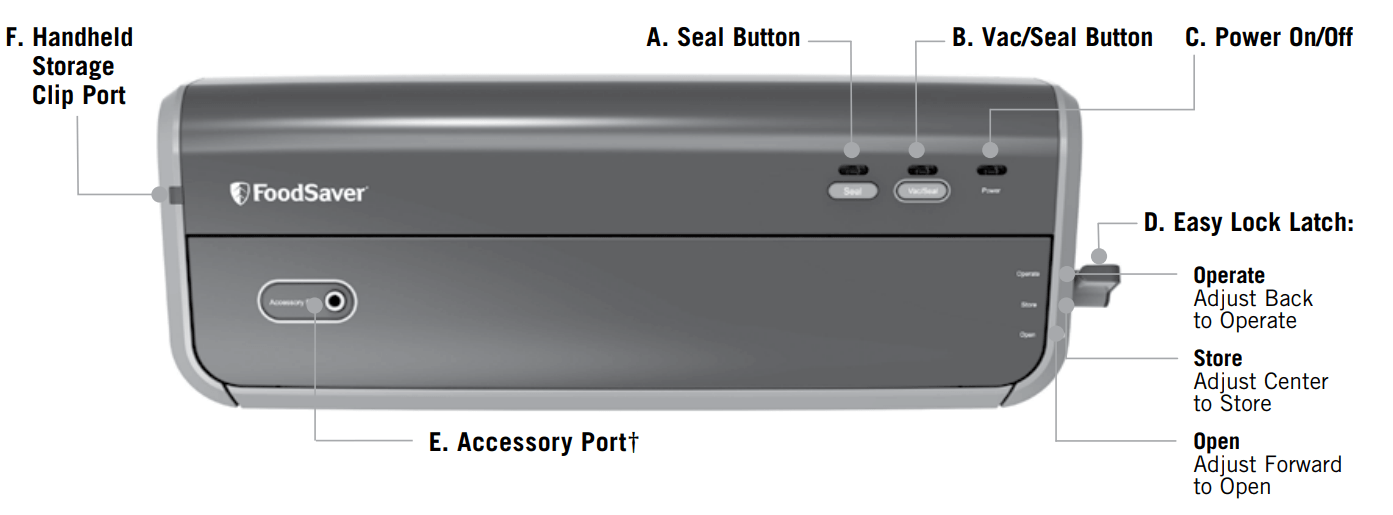
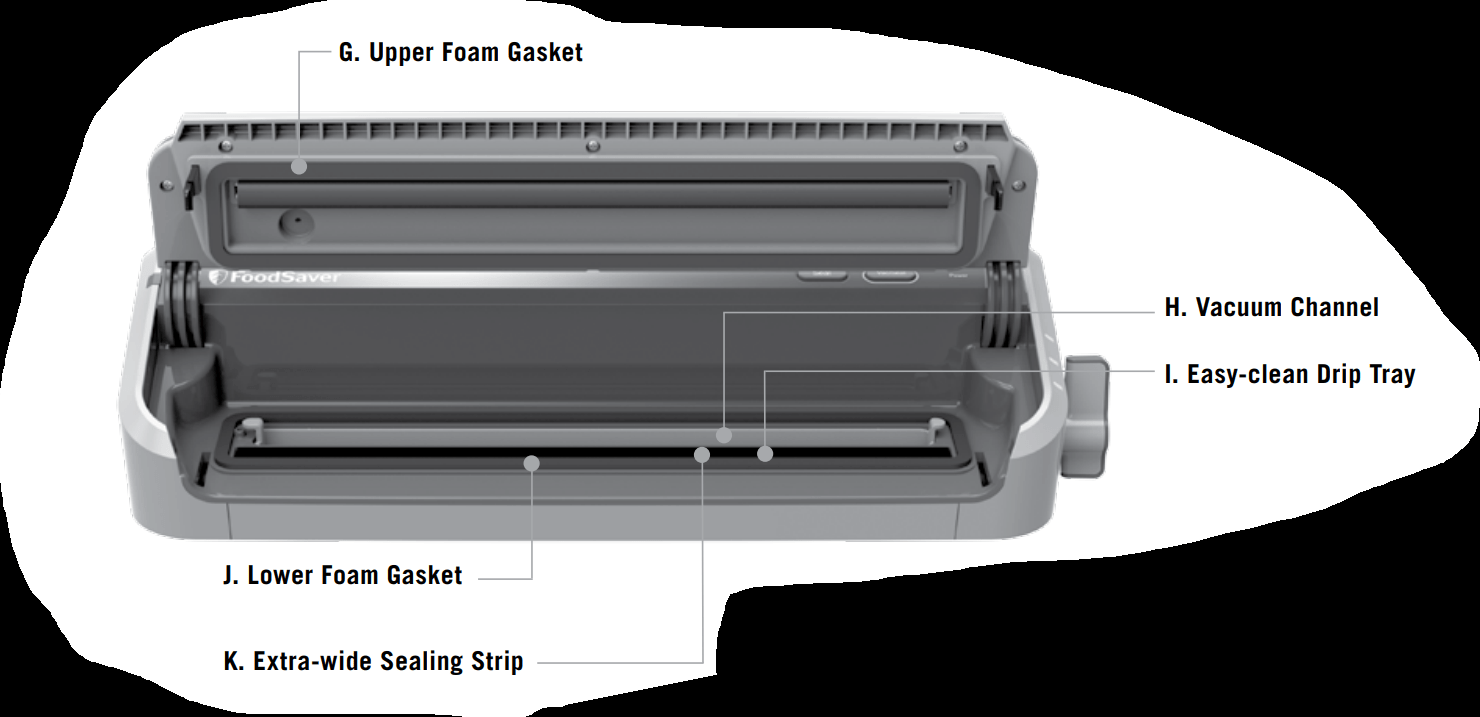
Optional Accessories (sold separately)
Handheld Sealer with Clip
| Use with zipper bags and canisters, ideal for fresh foods and snacks. Conveniently store Handheld Sealer with appliance using companion clip. |  |
CONTROL PANEL
The user-friendly, intuitive control panel makes it easy for you to get the most out of your FoodSaver® System:
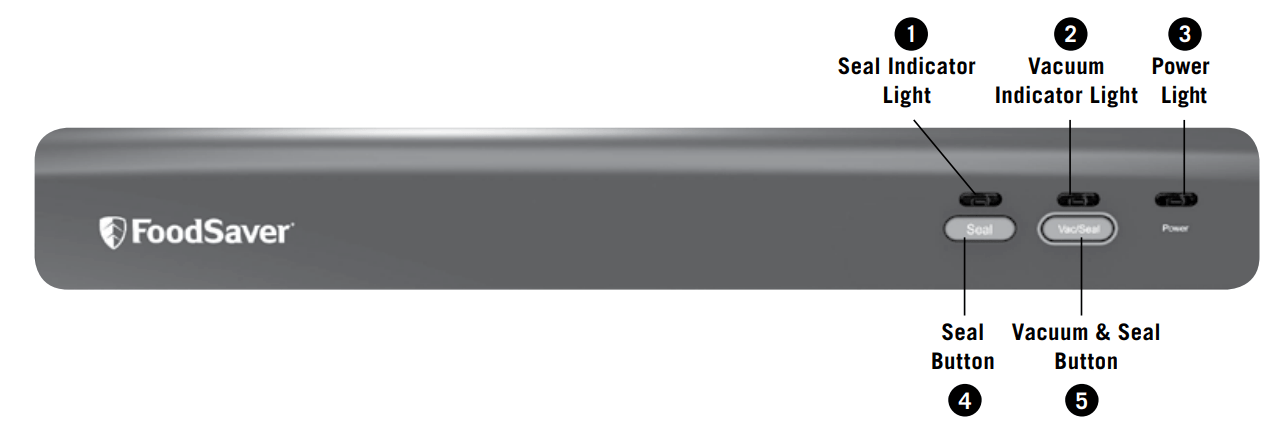
Seal Indicator Light
This light has two uses:
- Constant light indicates Sealing process is engaged.
- Flashes to indicate error.
Vacuum Indicator Light
Shows Vacuum and Seal process is engaged. Shuts off when the full process is finished.
Power Light
Illuminates when the unit is in the OPERATE position. Shuts off automatically when latch is not in
OPERATE position.
Seal Button
This button has three uses:
- Press to create a seal when making bags from a FoodSaver® Roll.
- Press to immediately stop the vacuum process and begin sealing the bag. This prevents crushing delicate items such as bread, cookies and pastries.
- Press to create a seal on multilayer film bags (such as a potato chip bag) to keep food sealed airtight.
Vacuum & Seal Button
This button has two uses:
- Press to vacuum seal and seal food airtight. Appliance shuts off automatically.
- Press to pause vacuum process at any point.
OPERATION
1. Make a Bag from a FoodSaver® Roll
| 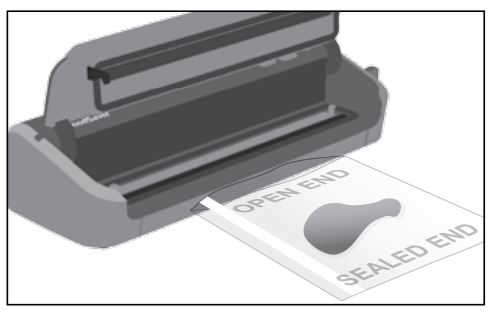 Place Bag on Sealing Strip  Close and turn Easy Lock Latch to OPERATE position 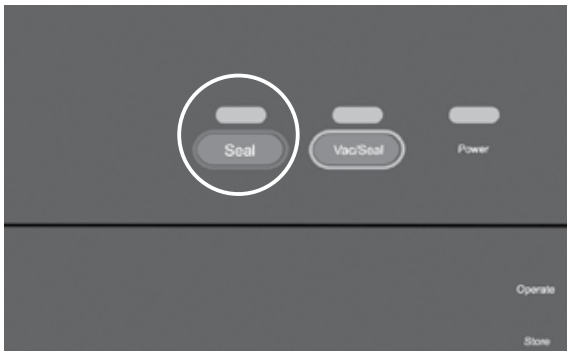 Press Seal Button |
2. Vacuum Seal with FoodSaver® Bags
Note: Let appliance cool down for 20 seconds after each use. Always store appliance with the Easy Lock Latch in the center STORE position. | 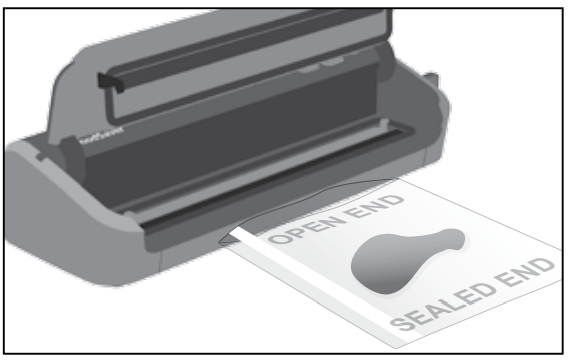 Place Bag in Vacuum Channel  Close and Latch Lid  Press Vacuum & Seal Button |
Important Tips:
To minimize Waste do not insert too much. Only insert bag over the edge of the removable drip tray.
3. Vacuum Seal with FoodSaver® Accessories
|  Connect Accessory Hose to both accessory port on appliance & port on accessory 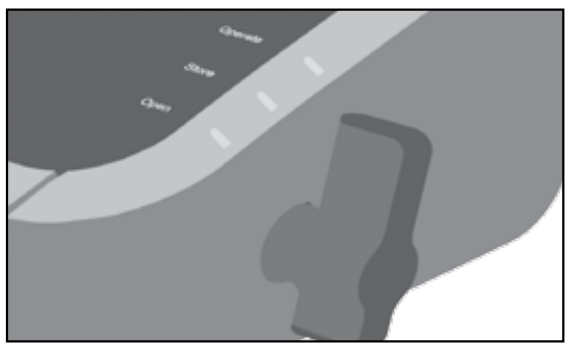 Close and turn Easy Lock Latch to the OPERATE position 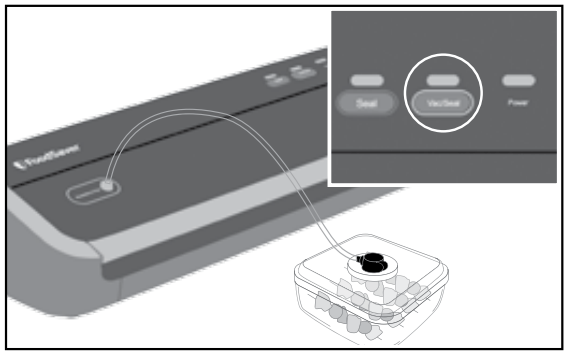 Press Vacuum & Seal Button |
4. Use Handheld Sealer with Vacuum Zipper Bags
|  |
5. Open FoodSaver® Accessories After Sealing
FoodSaver® Vacuum Sealing Canisters without large knob on lid)
- To release vacuum and open, push gray rubber button on lid.
FoodSaver® Bulk Canisters and Quick Marinators with large knob on lid) and Universal Lids.
- To release vacuum and open, turn knob on lid to Open.
FoodSaver® Jar Sealer with Mason Jars
- For use with Ball® and Kerr® brand Mason jars only.
- Important: Do NOT use screw bands when vacuum sealing jars. To open, wedge spoon between Mason jar lid and highest part of threaded rim. Twist spoon gently to release vacuum.
FoodSaver® Bottle Stoppers
- To release vacuum and open, twist and pull up on Bottle Stopper.
FoodSaver® Deli Containers
- To release vacuum and open, lift container lid.
SEALING
The vacuum sealing process extends the life of foods by removing most of the air from the sealed container, thereby reducing oxidation, which affects nutritional value, flavor and overall quality.
Removing air can also inhibit growth of microorganisms, which can cause problems under certain conditions:
Mold – Easily identified by its fuzzy characteristic. Mold cannot grow in a low oxygen environment, therefore vacuum sealing can slow the growth of mold.
Yeast – Results in fermentation, which can be identified by smell and taste. Yeast needs water, sugar and a moderate temperature to grow. It causes also survive with or without air. Slowing the growth of yeast requires refrigeration, while freezing stops it completely.
Bacteria – Results in an unpleasant odor, discoloration and/or soft or slimy texture. Under the right conditions, anaerobic bacteria such as Clostridium Botulinum (the organism that causes Botulism) can grow without air and sometimes cannot be detected by smell or taste. Although it is extremely rare, it can be very dangerous.
To preserve foods safely, it is critical that you maintain low temperatures. You can significantly reduce the growth of microorganisms at temperatures of 40°F (4°C) or below. Freezing at 0°F (-17°C) does not kill microorganisms, but stops them from growing. For long-term storage, always freeze perishable foods that have been vacuum sealed, and keep refrigerated after thawing.
It is important to note that vacuum sealing is NOT a substitute for canning and it cannot reverse the deterioration of foods. It can only slow down the changes in quality. It is difficult to predict how long foods will retain their top-quality flavor, appearance or texture because it depends on age and condition of the food on the day it was vacuum sealed.
IMPORTANT: Vacuum sealing is NOT a substitute for refrigeration or freezing. Any perishable foods that require refrigeration must still be refrigerated or frozen after vacuum sealing.
FOOD PREPARATION AND REHEATING
Thawing and Reheating Vacuum-Sealed Foods
Always thaw foods in either refrigerator or microwave — do not thaw perishable foods at room temperature.
To reheat foods in a microwave in a FoodSaver® Bag, always cut corner of the bag before placing it on a microwave-safe dish. However, to avoid hot spots, do not reheat bone-in meat or greasy foods in microwave within a FoodSaver® Bag. You can also reheat foods in FoodSaver® Bags by placing them in water at a low simmer below 170°F (75°C).
Preparation Guidelines for Meat and Fish:
For best results, pre-freeze meat and fish for 1-2 hours before vacuum sealing in a FoodSaver® Bag.
This helps retain the juice and shape, and guarantees a better seal.
If it’s not possible to pre-freeze, place a folded paper towel between meat or fish and top of bag, but below seal area. Leave paper towel in bag to absorb excess moisture and juices during vacuum sealing process.
Note: Beef may appear darker after vacuum sealing due to the removal of oxygen. This is not an indication of spoilage.
Preparation Guidelines for Hard Cheeses:
To keep cheese fresh, vacuum seal it after each use. Make your FoodSaver® Bag extra long, allowing one inch of bag material for each time you plan to open and reseal in addition to the inch room you normally leave between contents and seal. Simply cut sealed edge and remove cheese. When you’re ready to reseal the cheese, just drop it in bag and reseal.
IMPORTANT: Due to the risk of anaerobic bacteria, Soft cheeses should never be vacuum sealed.
Preparation Guidelines for Vegetables:
Vegetables need to be blanched before vacuum sealing. This process stops the enzyme action that could lead to loss of flavor, color and texture.
To blanch vegetables, place them in boiling water or in the microwave until they are cooked, but still crisp. Blanching times range from 1 to 2 minutes for leafy greens and peas; 3 to 4 minutes for snap peas, sliced zucchini or broccoli; 5 minutes for carrots; and 7 to 11 minutes for corn on the cob.
After blanching, immerse vegetables in cold water to stop the cooking process. Finally, dry vegetables on a towel before vacuum sealing.
Note: All vegetables (including broccoli, brussels sprouts, cabbage, cauliflower, kale, turnips) naturally emit gases during storage. Therefore, after blanching, they must be stored in freezer only.
When freezing vegetables, it is best to pre-freeze them for 1-2 hours or until solidly frozen. To freeze vegetables in individual servings, first place on a baking sheet and spread them out so they are not touching. This prevents them from freezing together in a block. Once they are frozen, remove from baking sheet and vacuum seal vegetables in a FoodSaver® Bag. After they have been vacuum sealed, return them to the freezer.
IMPORTANT: Due to the risk of anaerobic bacteria, Fresh mushrooms, onions and garlic should never be vacuum sealed.
Preparation Guidelines for Leafy Vegetables:
For best results, use a canister to store leafy vegetables. First wash the vegetables, and then dry with a towel or salad spinner. After they are dried, put them in a canister and vacuum seal as normal. Store in refrigerator.
Preparation Guidelines for Fruits:
When freezing soft fruits or berries, it is best to pre-freeze them for 1-2 hours or until solidly frozen. To freeze fruit in individual servings, first place on a baking sheet and spread them out so they are not touching. This prevents them from freezing together in a block. Once they are frozen, remove from baking sheet and vacuum seal fruit in a FoodSaver® Bag. After they have been vacuum sealed, return them to the freezer.
You can vacuum seal portions for baking, or in your favorite combinations for easy fruit salad all year round. If storing in the refrigerator, we recommend using a FoodSaver® Canister.
Preparation Guidelines for Baked Goods:
To vacuum seal soft or airy baked goods, we recommend using a FoodSaver® Canister so they will hold their shape. If using a bag, pre-freeze for 1-2 hours or until solidly frozen. To save time, make cookie dough, pie shells, whole pies, or mix dry ingredients in advance and vacuum seal for later use.
Preparation Guidelines for Coffee and Powdery Foods:
To prevent food particles from being drawn into vacuum pump, place a coffee filter or paper towel at top of bag or canister before vacuum sealing.
You can also place the food in its original bag inside a FoodSaver® Bag, or use a FoodSaver®Universal Lid with the original container to vacuum seal.
Preparation Guidelines for Liquids:
Before you vacuum seal liquids such as soup stock, pre-freeze in a casserole dish, loaf pan or ice cube tray until solid. Remove frozen liquid from pan and vacuum seal in a FoodSaver® Bag. You can stack these “frozen bricks” in your freezer. When you’re ready to use, just cut corner of bag and place in a dish in microwave or drop into water at a low simmer, below 170°F (75°C).
To vacuum seal non-carbonated bottled liquids, you can use a FoodSaver® Bottle Stopper with the original container. Remember to leave at least one inch of room between contents and bottom of Bottle Stopper. You can re-seal bottles after each use.
Preparation Guidelines for Make-ahead Meals, Leftovers and Sandwiches:
Efficiently store your make-ahead meals, leftovers and sandwiches in the stackable, lightweight
FoodSaver® containers. They are microwaveable, top rack dishwasher safe and come with a custom adaptor. The lightweight containers will be ready to head off to the office, to school or the great outdoors whenever you are!
Preparation Guidelines for Snack Foods:
Your snack foods will maintain their freshness longer when you vacuum seal them. For best results, use a FoodSaver® Canister for crushable items like crackers.
Vacuum Sealing Non-Food Items
The FoodSaver® Vacuum Sealing System also protects non-food items from oxidation, corrosion and moisture. Simply follow the directions to vacuum seal items using FoodSaver® Bags, Canisters and Accessories.
- To vacuum seal silver, wrap fork tines in soft cushioning material, such as a paper towel, to avoid puncturing bag, and seal as normal. Your silver will be clean, fresh and untarnished right when you need it for your next dinner gathering.
- Your FoodSaver® Bags are ideal for outdoor excursions. For camping and hiking, keep your matches, maps and food dry and compact.
- To have fresh water for drinking, simply fill a FoodSaver® Bag with ice, vacuum seal it, and when needed, let the ice pack melt. You can trim the corner off the bag to make a spout for drinking or pouring.
- If you’re going sailing or boating, you can vacuum seal your food, extra batteries, memory cards, cash, identification cards, boating license and a dry change of clothes. Just remember to bring scissors or a knife to open the bags when you need them!
- To keep emergency kits safe and dry, vacuum seal flares, batteries, flashlights, matches, candles, first aid kits, extra food and other necessities. Your emergency items will stay dry and organized in your home, car, boat or RV.
CARE & CLEANING
To Clean Appliance:
Remove Power Cord from electrical outlet. Do not immerse in liquid. Check Gaskets and around Drip Tray to make sure they are free from food materials. Wipe off Gasket with warm soapy cloth if needed. Upper and Lower Gaskets may be removed for cleaning. Clean with warm, soapy water. The Removable Drip Tray makes cleanup easy when small amounts of liquids are inadvertently pulled into the Vacuum Channel during vacuum process. Empty Drip Tray after each use. Wash in warm soapy water or place on top rack of dishwasher. Dry thoroughly before re-inserting into the appliance. Always leave lid latch in STORE position. Never store lid in OPERATE position as gaskets may become compressed. When appliance is left in OPERATE position, the internal gaskets become compressed and the unit may not function properly (see below). | 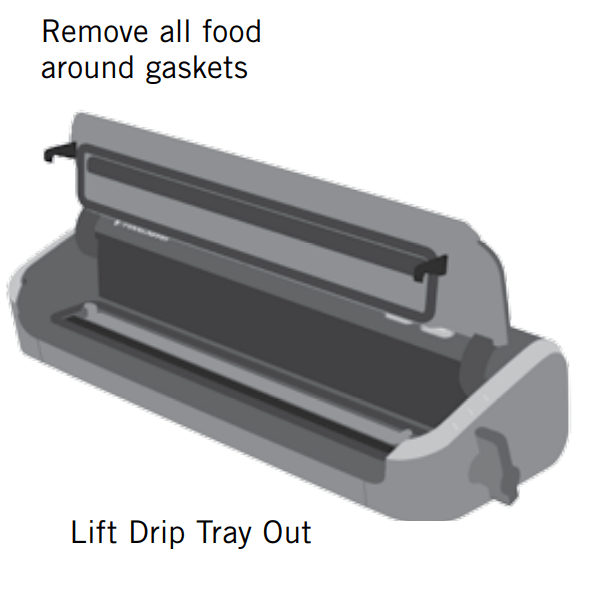 |
To Store Appliance:
Clean unit thoroughly as detailed above. After the unit has been cleaned and allowed to fully dry, close lid and push the Easy Lock Latch into the STORE (middle) position. This setting will keep the lid closed but prevents any undue pressure from being applied to the internal sealing gaskets of the unit. Always leave lid latch in STORE position when not in use. Never store lid in OPERATE position as gaskets may become compressed. When appliance is left in closed position, the Gaskets become compressed and the unit may not function properly. | 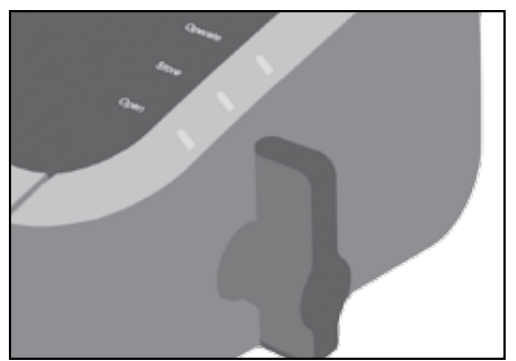 Push the latch into the center position to store. |
TROUBLESHOOTING
| Problem | Solution |
|---|---|
| Red Seal LED Flashing |
|
| Vacuum Pump is running, but bag is not evacuating |
|
| Gasket is loose or has a tear | Take out the gasket, clean it and reinsert the Gasket into the Vacuum Channel (See Care and Cleaning). |
| Bag is not sealing properly |
|
| No lights on the control panel |
|
| Nothing happens when Latch is closed and Button is pressed |
|
| Cannot insert bag into machine |
|
| Air was removed from the bag, but now air has re-entered |
|
| Bag melts |
|
| Container does not vacuum |
|
IMPORTANT TIPS
- Vacuum sealing is NOT a substitute for the heat process of canning. Perishables still need to be refrigerated or frozen.
- For best results, use only with FoodSaver® Bags, Rolls, Containers and Accessories.
- During the vacuum sealing process, small amounts of liquids, crumbs or food particles can be inadvertently pulled into the Vacuum Channel. Empty the Drip Tray after each use.
- Avoid overfilling, always leave at least 3 inches of bag material between bag contents and top of bag. This allows room for the bag material to cinch tightly against the food and prevents the bag from pulling out of the Vacuum Channel during the sealing process. Then leave at least one additional inch of bag material for each time you plan to reuse bag.
- Do not create your own side seams for a FoodSaver® Bag. These bags are manufactured with a special side seam, which is sealed all the way to the outer edge.
- To prevent wrinkles in the seal when vacuum sealing bulky items, gently stretch bag flat while inserting bag into Vacuum Channel and continue to hold bag until vacuum pump starts.
- When you are vacuum sealing items with sharp edges (dry spaghetti, silverware, etc.), protect bag from punctures by wrapping item in soft cushioning material, such as a paper towel. You may want to use a canister or Mason jar instead of a bag.
- When using accessories, remember to leave one inch of space at top of canister or container.
- Pre-freeze fruits and blanch vegetables before vacuum sealing for best results.
- Wait 20 seconds between seals to allow appliance to cool.
- Never store lid in OPERATE position
See other models: FSFSSL4840000 FM2435 FSFSSL5860-DTC GM710-000 VS0150 POWERVAC
